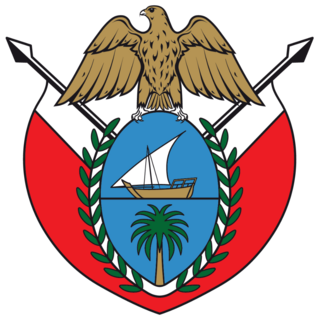Related Research Articles
Sheikh Dhiyab ibn Isa Al Nahyan was the Sheikh of the Bani Yas of the Liwa Oasis from 1761 to 1793 and the founder of the Al Bu Falah dynasty, which still rules Abu Dhabi, the capital of the United Arab Emirates (UAE), today.
The Marar is a tribe of the United Arab Emirates (UAE), a subsection of the Bani Yas.
The Bani Kaab is an Arab tribe in Oman and the United Arab Emirates, also evident in other Gulf countries.

The House of Al Falasi is both a name of a tribe and a name of its Al Maktoum branch.
The Al Bu Shamis or Al Shawamis is an Arab tribe of the United Arab Emirates, located mainly in the United Arab Emirates and Northern Oman.
Maktoum bin Butti was the joint founder and first ruler of Dubai, today one of the United Arab Emirates, alongside Obeid bin Said bin Rashid, with whom he led a migration of the Al Bu Falasah from Abu Dhabi, seceding from the Bani Yas.
Obeid bin Said bin Rashid was the first Ruler of Dubai under the Al Bu Falasah, jointly leading a migration of the tribe from Abu Dhabi alongside Maktoum bin Butti bin Sohail. He ruled for three years prior to his death in 1836.
Sheikh Rashid bin Ahmad Al Mualla was the Ruler of Umm Al Quwain from 1904–1922, one of the Trucial States and today one of the seven emirates forming the United Arab Emirates (UAE). He gained influence over the tribes of the interior at the expense of the pre-eminent Trucial Ruler of the time, Sheikh Zayed bin Khalifa Al Nahyan.
The Bani Qitab is an Arab tribe of the United Arab Emirates (UAE) and Oman. The singular form of the name, Al Ketbi, is a common family name in the Northern UAE today. Consisting of a settled southern section and a nomadic northern section, the tribe was long influential in the conduct of affairs in the interior of the Trucial States. The Northern branch mostly settled in the inland towns of Dhaid and Al Falayah.
The Na'im is an Arab tribe in the United Arab Emirates. The tribe is also present in other gulf countries.
Sheikh Tahnun bin Shakhbut Al Nahyan was the Ruler of Abu Dhabi from 1818–1833. Having deposed his brother Muhammad bin Shakhbut Al Nayhan with his father's support, he ruled in his father's name. Under Tahnun, Abu Dhabi became a Trucial State in 1820, eventually becoming the capital of the United Arab Emirates (UAE).
Sheikh Saeed bin Tahnun Al Nahyan was the ruler of Abu Dhabi, one of the Trucial States which today form the United Arab Emirates (UAE), from 1845 to 1855.
Sheikh Hamdan bin Zayed bin Khalifa Al Nahyan was the ruler of Abu Dhabi from 1912 to 1922.
The AlManasir is a tribe of the United Arab Emirates (UAE). Nomadic, warlike and fiercely independent, they roamed between Buraimi and Qatar, the Persian Gulf coast to Liwa and also settled in the Northern emirates. They subsisted through date farming, pearling and moving goods with their camel trains, as well as camel breeding.
The Mazari is an Arab tribe of the United Arab Emirates (UAE). The Mazari settled throughout the Trucial States but principally in Abu Dhabi. They are considered a subsection of the Bani Yas and formed the majority of the Bedouin component of that federation of tribes.
The Dhawahir is a tribe of the United Arab Emirates (UAE). The tribe's main centre was the Buraimi Oasis and the village, then town of Al Ain. They have long had a strong alliance with the Ruling family of Abu Dhabi, the Al Nahyan, and the Bani Yas confederation.
The Sudan is an Arab tribe of Qahtanite origin in the United Arab Emirates (UAE), Qatar and other Gulf states.
The Awamir is a Bedouin Arab tribe in the United Arab Emirates (UAE) and Oman. Warlike and fiercely independent, they were camel breeders, raiders and occasionally date farmers before settling in the 1960s.
The Duru is a tribe of the United Arab Emirates (UAE). A relatively small tribe, they nevertheless managed to intersperse themselves in a number of territorial conflicts which broke out throughout the Trucial States in the 20th century.
Sheikh Hazza bin Sultan Al Nahyan was the brother of Sheikh Shakhbut bin Sultan Al Nahyan, Ruler of Abu Dhabi from 1928 to 1966, and Sheikh Zayed bin Sultan Al Nahyan, Ruler of Abu Dhabi from 1966 to 2004 and the UAE's first President. Hazza was the Ruler's Representative in the Western Region of Abu Dhabi.
References
- ↑ Said., Zahlan, Rosemarie (2016). The Origins of the United Arab Emirates : a Political and Social History of the Trucial States. Taylor and Francis. p. 241. ISBN 9781317244653. OCLC 945874284.
{{cite book}}: CS1 maint: multiple names: authors list (link) - 1 2 Lorimer, John (1915). Gazetteer of the Persian Gulf. British Government, Bombay. p. 765.
- ↑ Wilson, Graeme (1999). Father of Dubai. Media Prima. p. 22.
- ↑ Heard-Bey, Frauke (2005). From Trucial States to United Arab Emirates : a society in transition. London: Motivate. p. 465. ISBN 1860631673. OCLC 64689681.
- ↑ Heard-Bey, Frauke (2005). From Trucial States to United Arab Emirates : a society in transition. London: Motivate. p. 242. ISBN 1860631673. OCLC 64689681.
- ↑ Wilson, Graeme (199). Father of Dubai. Media Prima. p. 23.
- ↑ Lorimer, John (1915). Gazetteer of the Persian Gulf. British Government, Bombay. p. 766.
